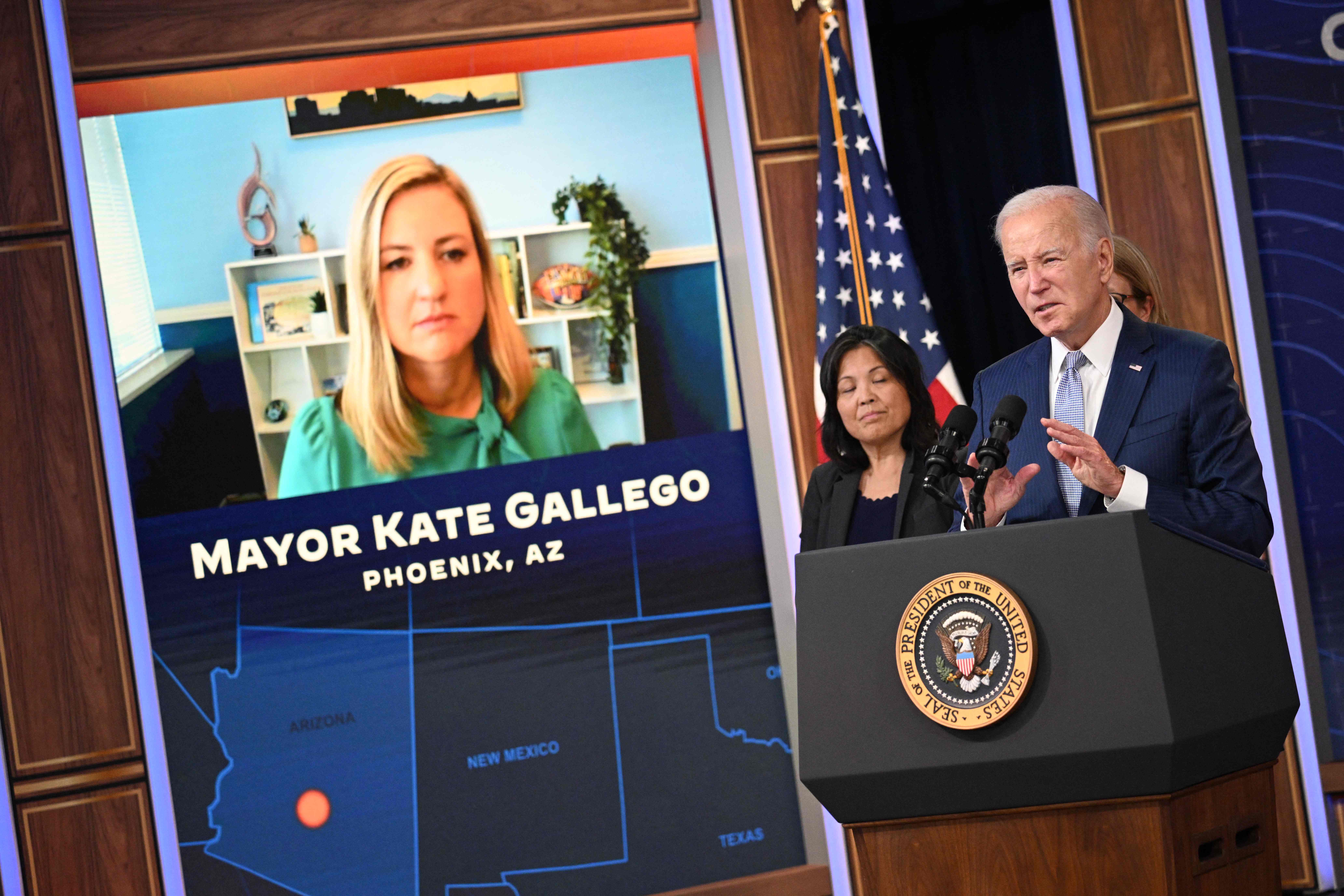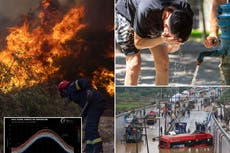Biden announces more measures to combat extreme heat as 100-degree temperatures spread north
As the relentless 100-degree temperatures continue in the south, a dangerous heatwave was spreading north into central and eastern regions on Thursday
Hot on the heels of news that July 2023 is the hottest month in human record, President Joe Biden has announced new steps to combat extreme heat in the United States.
More heat protections can’t come soon enough. Millions of people in the southern half of the country have faced relentless, 100-degree temperatures this summer with little respite forecast in the coming days. A “dangerous” heatwave was also spreading north into central and eastern regions on Thursday, the National Weather Service (NWS) reported.
President Biden was joined at the White House on Thursday via video by Mayor Kate Gallego of Phoenix, Arizona, and Mayor Ron Nirenberg of San Antonio, Texas, two southwestern cities facing some of the worst extremes.
Heat is the deadliest of climate disasters, the president said.
“I don’t think anybody honestly believes anymore that climate change is not a serious problem,” Mr Biden added before referring to the spate of deadly flash flooding in the Northeast, a record heat index of 125F in Puerto Rico, and wildfires in the west this summer.
Among the new measures are improvements to weather forecasts and making sure drinking water is more easily accessible, according to the White House, while the Department of Interior is spending $152m to improve water storage capacity in western states where drought is a critical issue.
Mr Biden highlighted a new “hazard alert” from the Department of Labor to make sure workers and employees understand risks, and increased inspections at work sites, particularly in agriculture and construction where people are mostly outdoors.
But there is currently no overarching federal protection for workers during extreme heat. Instead, there’s a hodge-podge of state and local regulations that leave people vulnerable. In Texas, for example, Governor Greg Abbott is preparing to eliminate local protections which require water breaks for workers.
In Dallas, a postal worker died last month while on his route in 115-degree heat, and in Harrison County, Texas, a 35-year-old lineman working to restore power died, likely from heat exhaustion. More than a dozen deaths in Texas have been caused by extreme heat.

In Phoenix, every day in July has topped 110F and 18 deaths linked to heat have been reported in Maricopa County, where the city is located, since April. Dozens more deaths are being investigated.
Farm workers have also died this month in Florida.
Mr Biden called taking away the right to a water break “outrageous” on Thursday.
On Monday, more than 100 members of Congress sent a letter to President Biden calling on him to immediately implement a workplace heat standard “given the dire threat to the lives of workers exposed to extreme heat”. It was followed by a thirst strike by some Democrats, labour unions and climate activists at the US Capitol.
The Occupational Safety and Health Administration (OSHA) said it is working towards a federal standard that would require employers to provide adequate water and rest breaks to outdoor workers, as well as medical services and training to address signs and symptoms of heat-related illness.
The Biden administration has directed funding from the Inflation Reduction Act to deal with America’s worsening climate reality.
The site Heat.gov, was established as a hub for information on where alerts and advisories have been issued across the country along with health advice for keeping cool.
The US Forest Service is spending $1bn to plant more trees across cities while the Department of Housing and Urban Development is opening more cooling centers and adapting buildings so they absorb less heat.
At the city level, Mayor Gallego and Mayor Nirenberg explained programs of “cool callers” who go door-to-door to check on vulnerable people, “cool pavement” schemes, and the distribution of cooling kits.
“We are often called the Valley of Sun... but this summer has been unprecedented,” said Mayor Gallego. “We feel like we are very much on the frontlines... but we are working to out -innovate climate change.”
On Thursday, scientists made the grim announcement that July 2023 is set to be the hottest month on record – and likely in 120,000 years.
The record-breaking average global mean temperature – the overall reading if you could stick a thermometer at every location on Earth – was confirmed by scientists at the European Copernicus Climate Change Service and World Meteorological Organization on Thursday, based on analysis of international climate and weather datasets.
“Climate change is here. It is terrifying. And it is just the beginning,” United Nations Secretary-General Antonio Guterres said on Thursday morning in New York.
“The era of global warming has ended; the era of global boiling has arrived.”
In the US, a dangerous heatwave is bedding in on Thursday for much of the Northeast with daytime high temperatures approaching 100F. When combined with oppressive humidity, this will create “real feel” heat indexes of above 105F, NWS said.
Cities including Washington DC, Philadelphia, and Boston are under a Heat Advisory, while an Excessive Heat Warning is in effect for the New York City metro area.
Meanwhile, the ongoing heatwave in the Southwest shows no sign of easing until at least Saturday with heat index values up to 115F possible.





Bookmark popover
Removed from bookmarks